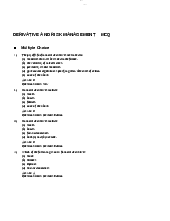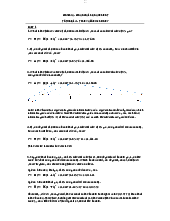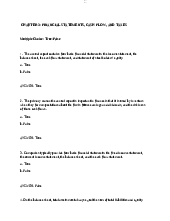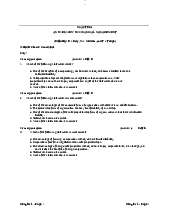







Preview text:
lOMoARcPSD|44744371 lOMoARcPSD|44744371
1. A. a £100 U.K. good will cost $151 in the U.S. Explanation:
The exchange rate is given as $1.51/£, meaning 1 British pound equals 1.51 U.S. dollars.
If a product in the U.K. costs £100, we multiply it by the exchange rate: £100×1.51=151 USD D. It appreciates Explanation:
When a currency increases in value relative to other currencies, it is said to appreciate.
For example, if the exchange rate of 1 USD changes from 1.51 to 1.60 GBP, the U.S.
dollar has appreciated because it now buys more British pounds.
On the other hand, a decrease in a currency's value is called depreciation.
3 :D: When a currency appreciates, it becomes stronger relative to other currencies. As a result:
Exports from that country become more expensive for foreign buyers, as they need
more of their own currency to buy the appreciated currency’s goods.
Imports to the appreciating country become cheaper because it takes fewer units of the
stronger currency to buy foreign goods.
For example, if the USD appreciates relative to the GBP, American goods will cost more
for British consumers, while British goods will appear cheaper to Americans.
4. The law of one price states that in the absence of transportation costs and trade barriers,
identical goods should have the same price in different countries when expressed in a common currency.
If the French price level rises by 10% and the U.S. price level rises by 5%, the price differential is: 10%−5%=5%
This means that French goods are becoming relatively more expensive. As a result, the
U.S. dollar will appreciate by 5% against the euro (or any other currency used by France)
to maintain the relative purchasing power parity.
5. Factors Limiting PPP:
- Goods that are not identical (Option A & C): lOMoARcPSD|44744371 o
PPP assumes identical goods, but in reality, product quality, brand value, and
consumer preferences vary across countries, affecting prices. -
Trade barriers (Option D): o
Tariffs, quotas, and other trade restrictions create price differences between
countries, disrupting PPP predictions. -
Transport costs and non-tradable goods: o
Some goods (like real estate) cannot be easily traded, and transportation
costs also prevent price equalization.
Why Option B is Incorrect:
Different methods of calculating growth rates refer to statistical differences in measuring
economic growth, not exchange rates. This is unrelated to PPP’s predictive power.
PPP is more focused on price levels and inflation differentials between countries
rather than growth rate measurements. 6. Options Analysis:
1. A decrease in the demand for a country’s exports (Option A): o
A decrease in demand for exports typically leads to currency depreciation, as
it means less foreign currency is being exchanged for the domestic currency. o
Conclusion: Does not cause appreciation.
2. A rise in a country's relative price level (Option B): o
If a country’s price level rises relative to others, it usual y makes its goods more
expensive, leading to lower demand for exports and potential currency depreciation. o
Conclusion: Does not cause appreciation.
3. A relative decrease in the productivity of a country (Option C): o
A decrease in productivity compared to other countries general y means
that the economy is less efÏcient, which can lead to a weaker currency. o
Conclusion: Does not cause appreciation.
4. Increasing tariffs (Option D): o
While tariffs can protect domestic industries and potential y improve trade balance,
they can also lead to retaliatory measures and might not result in long-term currency
appreciation. However, if tariffs successful y protect industries and lead to trade
surpluses, it could support currency appreciation. But this is not guaranteed. o
Conclusion: This option can be nuanced but typically does not guarantee long-term appreciation. lOMoARcPSD|44744371 Conclusion:
Given the options provided, none of them straightforwardly lead to currency appreciation in
the long run. Typically, factors that could lead to appreciation include improvements in
productivity, increased foreign investment, or higher interest rates compared to other countries. 7. . 8. C 9.
A. An increase in the domestic interest rate: o
Higher domestic interest rates typical y attract foreign capital as investors seek
higher returns. This can lead to an appreciation of the domestic currency. o
Conclusion: This does not cause depreciation.
B. An increase in foreign interest rates: lOMoARcPSD|44744371 o
If foreign interest rates increase, it makes foreign investments more attractive to
investors. This can lead to capital outflows from the domestic economy as investors
move their funds abroad, resulting in a depreciation of the domestic currency. o
Conclusion: This does cause depreciation.
C. An increase in the expected export demand: o
Higher expected export demand typical y strengthens the domestic currency
because it increases the demand for the domestic currency (as foreign buyers
need to purchase the currency to pay for the exports). o
Conclusion: This does not cause depreciation.
D. An increase in productivity: o
Increased productivity can lead to higher economic growth and competitiveness.
This may attract foreign investment and potential y lead to currency appreciation. o
Conclusion: This does not cause depreciation. 10.
A. Cause the domestic currency to appreciate:
An increase in the money supply generally leads to lower interest rates. Lower interest
rates make a currency less attractive to investors, which typically results in
depreciation, not appreciation.
Conclusion: This is not correct.
B. Cause the domestic currency to either depreciate or appreciate, depending on the size of the change:
While the size of the change can influence the magnitude of the impact, a higher money
supply typically puts downward pressure on the currency value. It's more predictable
that it would lead to depreciation rather than uncertainty about appreciation.
Conclusion: This is not correct.
C. Cause the domestic currency to depreciate:
When the domestic money supply increases, it leads to lower interest rates, which
generally makes the currency less attractive to foreign investors. This often results in a
depreciation of the currency as demand decreases.
Conclusion: This is correct.
D. Cause the domestic currency to not change in value:
An increase in the money supply usually does affect the currency value, leading to
depreciation. It is unlikely that it would have no effect at all. lOMoARcPSD|44744371
Conclusion: This is not correct.
11. The interest-parity condition describes the relationship between interest rates and
expected exchange rate movements between two currencies. It states that:
The difference between the domestic interest rate and the foreign interest rate should equal the
expected change in the exchange rate (appreciation or depreciation) of the domestic currency. Analyzing Each Option:
A. The domestic interest rate equals the foreign interest minus the
expected appreciation of the domestic currency: o
This option correctly describes the interest-parity condition. It reflects that if the
domestic currency is expected to appreciate, the domestic interest rate can be lower
than the foreign interest rate, adjusted for the expected change in currency value. o
Conclusion: This is correct.
B. The expected return on domestic deposits equals the inverse of the
expected return on foreign deposits: o
This statement is incorrect and does not reflect the interest-parity condition.
Interest parity does not imply that returns are inverses of each other. o
Conclusion: This is not correct.
C. The domestic interest rate equals the foreign interest rate: o
This is only true in a special case where there is no expected change in the
exchange rate, which is not the general condition described by interest parity. o
Conclusion: This is not correct.
D. The expected return on domestic deposits equals the negative of the expected
return on foreign deposits: o
This statement is incorrect and does not represent the interest-parity
condition. It implies a contradictory relationship that is not relevant to interest rates or expected returns. o
Conclusion: This is not correct.
12. The demand curve for domestic assets being downward sloping means that as the price or
return of those assets changes, the quantity demanded changes in the opposite direction. Let's break down the options:
A. As the expected appreciation on dollar assets rises, the quantity demanded of dollar assets rises: lOMoARcPSD|44744371 o
When investors expect the value of dollar assets to increase (appreciate), they
are more inclined to buy those assets, which increases the quantity demanded.
This aligns with the concept of a downward-sloping demand curve. o
Conclusion: This is correct.
B. As the exchange rate rises, the quantity demanded of dollar assets rises: o
A rising exchange rate (for example, if the dollar strengthens against other
currencies) can actually reduce the demand for dollar assets if it makes foreign
investments relatively cheaper. Therefore, this does not reflect the downward-
sloping nature of the demand curve. o
Conclusion: This is not correct.
C. As the price of domestic assets rises, the quantity demanded of dollar assets rises: o
This statement is incorrect because it contradicts the law of demand; generally,
as the price of an asset rises, the quantity demanded decreases, not increases. o
Conclusion: This is not correct.
D. As the relative price of domestic assets rises, the quantity demanded of domestic assets: o
This option is incomplete but suggests that an increase in the relative price would
lead to a decrease in the quantity demanded, which aligns with typical demand behavior. o
Conclusion: This is not correct. 13.
Increase in Domestic Real Interest Rate: o
If the nominal interest rate rises due to an increase in the real interest rate (the
nominal rate minus inflation), this typically attracts foreign investment, as
investors seek higher returns. This increased demand for the domestic currency
leads to appreciation of the currency.
Increase in Expected Inflation Rate: o
If the nominal interest rate rises because of an increase in the expected inflation
rate, this suggests that the purchasing power of the currency is expected to
decline. Higher inflation general y erodes the value of money, leading to a
depreciation of the currency. Investors may seek better returns elsewhere,
resulting in less demand for the domestic currency.
So, if the domestic nominal interest rate rises due to an increase in the domestic real
interest rate, the domestic currency appreciates. lOMoARcPSD|44744371
If it rises due to an increase in the expected inflation rate, the domestic currency depreciates.
14. When people expect a currency (in this case, the dollar) to appreciate in value against
another currency (the euro), it influences their behavior in the following way:
1. Expectation of Appreciation:
o If investors believe that the dollar will become stronger relative to the euro, they
will anticipate making a profit from buying dollars now before the appreciation occurs. 2. Buying Dollars:
o As more people buy dollars in anticipation of its appreciation, the demand for
dollars increases. This increased demand for dollars will lead to the dollar appreciating against the euro. 3. Impact on the Euro: o
Conversely, as people buy dollars, there will be less demand for euros,
which could lead to a depreciation of the euro against the dollar.
15. Exchange Rate Overshooting refers to a phenomenon where the exchange rate adjusts to a
new equilibrium but initially overshoots before eventually stabilizing. Here’s how it relates to the options:
A. Occurs because the market has difficulty interpreting changes in the money supply: o
While market interpretations can influence volatility, this statement does
not directly address the concept of overshooting. o
Conclusion: This is not correct.
B. Occurs because an increase in the domestic money supply lowers domestic
interest rates in the short run, but they return to previous levels in the long run: o
This statement accurately describes the mechanism behind exchange rate
overshooting. An increase in the money supply typically lowers interest rates, which
can lead to a temporary depreciation of the currency. However, as expectations
adjust and other economic factors stabilize, interest rates may revert, causing the
exchange rate to adjust again, often overshooting in the process. o
Conclusion: This is correct.
C. Occurs because an increase in the domestic money supply has no effects
on domestic interest rates, but does raise foreign interest rates: o
This statement is incorrect because an increase in the domestic money supply
generally does affect domestic interest rates, usually lowering them. o
Conclusion: This is not correct. lOMoARcPSD|44744371
D. Occurs because an increase in the domestic money supply lowers domestic
interest rates in the long run but not the short run: o
This statement misrepresents the typical short-run effect of increased money
supply, which usually lowers interest rates in the short run as well. o
Conclusion: This is not correct.




